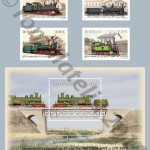 Answering the philatelists’ passion for history of technics themes, Romfilatelia introduces into circulation the postage stamps issue entitled “Locomotives”.Answering the philatelists’ passion for history of technics themes, Romfilatelia introduces into circulation the postage stamps issue entitled “Locomotives”.
Answering the philatelists’ passion for history of technics themes, Romfilatelia introduces into circulation the postage stamps issue entitled “Locomotives”.Answering the philatelists’ passion for history of technics themes, Romfilatelia introduces into circulation the postage stamps issue entitled “Locomotives”.
The railway technical adventure that will radically change the life of the inhabitants of this planet started in 1803 when Richard Trevithick (1771-1833), the Welsh engineer, built the first industrial steam engine in the world (“Tram-Engine”) in Coalbrookdale blacksmith’s shop. Within a short period of time, the one who registered his immortal name in the history of the steam engine (“Father of the Locomotive Engine”) and the railways in the world was the Englishman George Stephenson (1781-1848), who for more than 10 years, between 1814-1825, was the main locomotive manufacturer by substantially contribution to their development.
In 1823, at Newcastle upon Tyne, George Stephenson, his son Robert, Edward Pease and Michael Longridge set up “Robert Stephenson & Company”, the first locomotive factory in the world. The first orders received in 1824 came from Hetton mines and Stockton & Darlington Railway company (“Locomotion No.1”, “Hope”, “Diligence” and “Black Diamond”).
The stamp with the face value of 2.00 lei illustrates CFR 103 “Romania” locomotive B1-n2 Egst.-1869 type, making part of a representative series of 55 units, CFR 51-105, delivered in1869 by the German locomotive factory “Dr. Strousberg, vormals Georg Egestorff, Linden vor Hannover” for the lines of CFR Shareholders’ Society. It was a locomotive for mixed trains and it had the diameter of the driving and coupling wheels of 1,425 mm and a maximum running speed of 70 km/h.
The stamp with the face value of 3.00 lei illustrates CFR 28 “Codaesti” locomotive 2B-n2 Hart.-1887 type, making part of the series CFR 28-33 (6 units), delivered in 1887 by the German locomotive factory “Maschinenfabrik Richard Hartmann, Chemnitz”. It was a locomotive for express trains, used in the period 1887-1905 to tow the “Orient Express” trains on the route Varciorova – Turnu Severin – Balota – Pitesti – Bucuresti Nord (382 km). It had the diameter of the driving and coupling wheels of 1,906 mm and a maximum running speed of 115 km/h being the first type of locomotives from CFR fleet equipped with aleading bogie. Until the placing in the circuit in 1913 of the first PACIFIC locomotives (series CFR 2201-2240, type 2C1-h4), they were the fastest locomotives within the CFR network.
The stamp with the face value of 3.30 lei illustrates CFR 185 “Domnita Maria” locomotive, C-n2 StEG. Wien -1875 type, making part of a representative series of 35 units, CFR 151-185 (subsequently renumbered CFR 544-578), delivered in the period 1873-1875 by the Austrian locomotive factory “StEG, Wien“for the lines of CFR Shareholders’ Society. It was a locomotive for goods trains and it had the diameter of the driving and coupling wheels of 1,290 mm and a maximum running speed of 54 km/h. CFR 185 / CFR 578 – “Domnita Maria” locomotive (manufacture number 1408/1875) was the last locomotive of the series CFR 151-185 and it was named after Princess Marie (the only child of King Carol I who died at an early age).
The stamp with the face value of 9.10 lei illustrates CFR 001 “Lespezi” tender-locomotive, C-n2t Hainaut, Couillet -1884 type, making part of the series of tender-locomotives for narrow rails (ec.1,000 mm) CFR 001-006, delivered in 1884 and 1887 by the Belgian locomotive factory “Société Anonyme des Usines Métallurgiques du Hainaut, Couillet”. It had the diameter of the driving and coupling wheels of 900 mm and a maximum running speed of 47 km/h.
On the postage stamp of the souvenir sheet of the issue, with the face value of 8.10 lei are illustrated the compound-locomotives CFR 8008 and CFR 8003, 2C-n4v Bre.-1901 type, making part of the series CFR 8.001-8.010, delivered in 10 units in the period 1901-1902 by the Italian locomotive factory “Ing. Ernesto Breda & Co.-Stabilimento Meccanico, Milano”. Together withthe tender of 3 axles, they weighed 100 tf. (ton-force) and, in order to run, there were checked, reinforced and tested all the railway bridges on the main routes. The image on the souvenir sheet illustrates even the testing of a bridge, after it had been rebuilt, with two locomotives that had together 200 tf. They were compound-locomotives with four cylinders for express trains and they had the diameter of the driving and coupling wheels of 1,665 mm and a maximum running speed of 113 km/h being distributed to the depots of Bucharest, Iasi and Ploiesti.
The photographic and documentary assistance for the accomplishment of this postage stamps issue was provided by the engineer Ilie Popescu from S.N.T.F.C.-“CFR CALATORI” S.A. (Ministry of Transports).
Issue date: 2011-08-26



